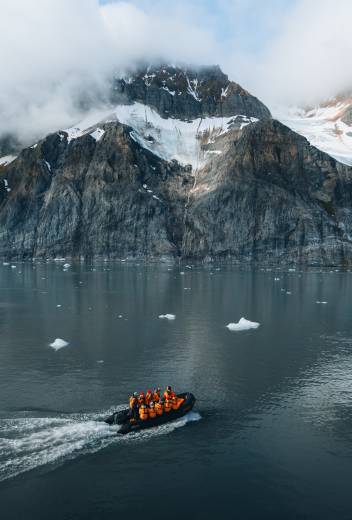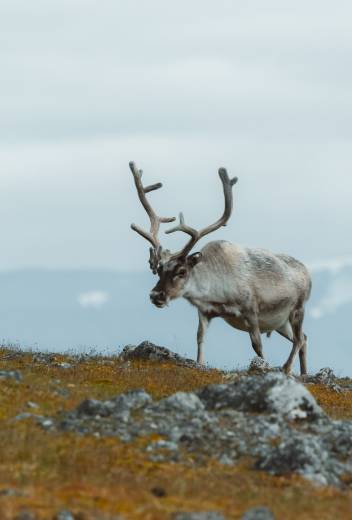Off the coast of the Boothia Peninsula, in the Canadian territory of Nunavut, is a sea of ice—literally. It’s late summer, so rather than a stable platform well suited for winter travel, the ice is broken up into hundreds of floes, which are large slabs of ice floating and bobbing together, making travel by dog sled or small boat impossible. Earlier in the day, we saw a polar bear out on the ice hunting.

Looking ashore, I see the Boothia Peninsula. The northernmost point of the actual North American continental landmass, just above 72° North. Lichens and Arctic tundra flowers cling to the rocky landscape, supporting a community of musk ox, Arctic hare, and maybe an occasional caribou. A west wind blows moody clouds across the northern tip of North America.
In conditions like this, it’s easy to imagine this scenario: you’re in a frozen Arctic wilderness. You have no access to cars or roads, airplanes or ships, and you’re 500 miles away from the nearest settlement with “regular” contact with the Outside World. You’re with three companions, and everything you need to survive for the next several years is packed neatly onto a couple of dog sleds. You have no map. It’s dark at night, and there are polar bears somewhere nearby.
This is the situation that Knud Rasmussen and two of his friends found themselves in in the early 1920s. They were more than a year into their Fifth Thule Expedition, a mission to traverse the Northwest Passage by dog sled in an effort to better understand the cultural connections across the Far North, from Greenland to Siberia. And at that point, things were going well.
Explorer and Anthropologist Knud Johan Victor Rasmussen
The name Knud Rasmussen might not be on most people’s list of most famous explorers of all time. But it should be. What Rasmussen accomplished in the early 20th century should be held in similar regard to names as notable as Captain Cook, Lewis and Clark, Roald Amundsen, and Ernest Shackleton. He was a legend.
Rasmussen’s history is long and fascinating, which if you’re interested, is beautifully documented in Stephen Bown’s book White Eskimo. But in short, it consisted of establishing the Thule Trading Post near modern day Qaanaaq, Greenland (located at 77° North), multiple expeditions into Greenland’s most inaccessible and northernmost fjords and coastlines, and regular (but brief) forays into elite Danish social circles. But what he is most known for is his massive Fifth Thule Expedition.

Knud Rasmussen’s Fearless Journey
Rasmussen was fortunate enough to be born into a world where Arctic survival skills are learned at a young age. He spoke Kalaallisut growing up in West Greenland (a language with a common thread throughout the Inuit Arctic) and was exposed to master hunters and sled makers in his hometown of Ilullisat (then Jakobshaven).
As a boy, Rasmussen heard countless stories about hunting expeditions gone bad that haunted people for years, natural forces and truces made with the wind and sea. The creation of the world, and the origin of “The People” further to the west across Baffin Bay. These stories intrigued Rasmussen, and sparked a lifelong passion to better understand—and record—the histories and oral narratives across the Arctic.
It was these stories, particularly those about the ancestors—his ancestors—who arrived from the west that gave him an unshakable desire to point his sled’s direction westward and keep going until he reached Siberia.
Across the Northwest Passage. By dog sled.
The Fifth Thule Expedition was monumental in scope when compared to previous Thule Expeditions to northern and eastern Greenland. Rasmussen and his team covered more than 18,000 miles by sled and foot, taking more than three years to traverse the Northwest Passage. From Baffin Island, through the heart of the Canadian Arctic, across the top of Alaska, and onto the shores of Russia’s Far East. (For comparison, the First Thule Expedition covered 620 miles.)
Imagine that. Out on the polar sea ice for three years, with full exposure to the groans and undulations of the ever-changing icy platform underfoot. Brief summer abundances of millions of migrating birds and thousands of caribou, and month upon month of blizzards and wind storms. Temperatures as low as -50 Celsius, huddling into caribou skins and snow shelters for “warmth” throughout the long winter nights. Brilliant displays of aurora borealis, framed by millions of stars and the Milky Way overhead. Traveling through the Arctic under man and dog power, the gradual changes in the landscape must have been an amazing to observe.
Rasmussen and his friends no doubt held an intimate relationship with the ice and the mountains, the sea and the animals, the sky and the weather. With the thought of polar bears always in the back of their minds.
Rather than covering miles as quickly as possible, the whole point of the Fifth Thule Expedition was to find people out on the vast and endless expanses of ice and snow—cultural relatives to his family and friends back in Greenland.
And his approach to these Arctic residents was one of humility. Rather than assuming he knew more than them, he understood that they carried with them echoes of Inuit culture and the original stories—stories dating back hundreds, if not thousands of years.
His mission wasn’t to teach. It was to learn. In this manner, Rasmussen traveled for days or weeks across the ice until he either saw a hunting party in the distance or spotted their sled tracks, introduced himself, and ultimately joined them in their camp until he felt it was the right time to continue moving westward.
He met dozens of families and observed firsthand the longitudinal evolution in sled design, hunting strategies, preferred animals for food and clothing, language and dialect, cultural customs and spirituality. It was, put simply, human relationships with the natural world.
He shared food and stories, made music and danced, and celebrated life with the people he met along the way. He recorded all that he could, published in numerous books, most notably in Across Arctic America and The People of the Far North.

More than three years later, Rasmussen and his friends emerged in Northwest Alaska. Their final push was across the sea ice in the Bering Strait, where they landed on the shores of Russia’s Far East. From Eastern Canada to Eastern Russia (the entire Northwest Passage) by dog sled, they gathered several volumes of priceless stories and observations along the way.
Follow in the Footsteps of the Great Explorer
The landscapes and animals, the weather and wind, and the people of the Northwest Passage all find themselves on the pages of books either written by Rasmussen or written about him. He was an Arctic addict, and he couldn’t be away from these wild lands for very long. His observations and narratives can be beautiful, but we often want to apply a tangible, three-dimensional reality to what we read in history books.
Traveling with Quark Expeditions in the Northwest Passage provides opportunities to awaken our senses and gives stories like Rasmussen’s dog sled journey through the Arctic a richer sense of reality, that third dimension that stops us in our tracks, makes us feel present in our moment and think to ourselves, “Wow, now this is what the Arctic is!” The sheer immensity of the landscapes is often difficult to comprehend, landscapes that, when physically exposed to their true scale, leave you with a tremendous and palpable sense of humility.

Standing on shore of a rocky beach on Devon Island or the Boothia Peninsula, we can hear what the Arctic wind actually sounds like, blowing uninterrupted across hundreds of miles of wilderness—the “barren lands.” We can feel the sting of that summer Arctic wind on our face and understand that to travel and survive in these lands—in winter—is a phenomenal demonstration of the strength of the human spirit.
Walking on shore next to polar bear tracks, visiting the remains of winter Thule and Inuit camps, and gazing out at the sea ice, we can feel the subtle intensity of the Arctic in our bones.
And of course, we can be invited into Arctic communities and presented with stories and smiles, laughter and dancing, warmth and generosity. And if we’re lucky, tastes of local delicacies. All privileges. I can see why Rasmussen was an Arctic addict.
Want to see and hear the polar north and these wild Arctic places for yourself? Join us aboard the Ocean Adventurer this year in the Northwest Passage.
Want to learn more about Knud Rasmussen and his travels? Consider reading White Eskimo by Stephen Bown, or This Cold Heaven by Gretel Ehrlich.









